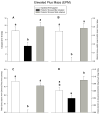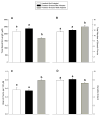Resilience against predator stress and dendritic morphology of amygdala neurons
- PMID: 19686780
- PMCID: PMC4022315
- DOI: 10.1016/j.bbr.2009.08.014
Resilience against predator stress and dendritic morphology of amygdala neurons
Abstract
Individual differences in coping response lie at the core of vulnerability to conditions like post-traumatic stress disorder (PTSD). Like humans, not all animals exposed to severe stress show lasting change in affect. Predator stress is a traumatic experience inducing long-lasting fear, but not in all rodents. Thus, individual variation may be a cross species factor driving responsiveness to stressful events. The present study investigated neurobiological bases of variation in coping with severe stress. The amygdala was studied because it modulates fear and its function is affected by stress. Moreover, stress-induced plasticity of the amygdala has been related to induction of anxiety, a comorbid symptom of psychiatric conditions like PTSD. We exposed rodents to predator stress and grouped them according to their adaptability based on a standard anxiety test (the elevated plus maze). Subsequently we investigated if well-adapted (less anxious) and mal-adapted (extremely anxious) stressed animals differed in the structure of dendritic trees of their output neurons of the right basolateral amygdala (BLA). Two weeks after exposure to stress, well-adapted animals showed low anxiety levels comparable to unstressed controls, whereas mal-adapted animals were highly anxious. In these same animals, Golgi analysis revealed that BLA neurons of well-adapted rats exhibited more densely packed and shorter dendrites than neurons of mal-adapted or unstressed control animals, which did not differ. These data suggest that dendritic hypotrophy in the BLA may be a resilience marker against lasting anxiogenic effects of predator stress.
Figures






Similar articles
-
A comparison of activation patterns of cells in selected prefrontal cortical and amygdala areas of rats which are more or less anxious in response to predator exposure or submersion stress.Physiol Behav. 2012 Feb 1;105(3):628-38. doi: 10.1016/j.physbeh.2011.09.016. Epub 2011 Sep 24. Physiol Behav. 2012. PMID: 21971366
-
Dendritic morphology of amygdala and hippocampal neurons in more and less predator stress responsive rats and more and less spontaneously anxious handled controls.Behav Brain Res. 2012 Jan 1;226(1):133-46. doi: 10.1016/j.bbr.2011.09.009. Epub 2011 Sep 12. Behav Brain Res. 2012. PMID: 21925210 Free PMC article.
-
Prolonged behavioral stress enhances synaptic connectivity in the basolateral amygdala.Neuroscience. 2006 Dec 1;143(2):387-93. doi: 10.1016/j.neuroscience.2006.08.003. Epub 2006 Sep 8. Neuroscience. 2006. PMID: 16962717
-
Protein synthesis and the mechanisms of lasting change in anxiety induced by severe stress.Behav Brain Res. 2006 Feb 28;167(2):270-86. doi: 10.1016/j.bbr.2005.09.019. Epub 2005 Oct 26. Behav Brain Res. 2006. PMID: 16256211
-
Predator Stress-Induced CRF Release Causes Enduring Sensitization of Basolateral Amygdala Norepinephrine Systems that Promote PTSD-Like Startle Abnormalities.J Neurosci. 2015 Oct 21;35(42):14270-85. doi: 10.1523/JNEUROSCI.5080-14.2015. J Neurosci. 2015. PMID: 26490866 Free PMC article.
Cited by
-
Glucocorticoids protect against the delayed behavioral and cellular effects of acute stress on the amygdala.Biol Psychiatry. 2012 Sep 15;72(6):466-75. doi: 10.1016/j.biopsych.2012.04.008. Epub 2012 May 8. Biol Psychiatry. 2012. PMID: 22572034 Free PMC article.
-
Distinct effects of repeated restraint stress on basolateral amygdala neuronal membrane properties in resilient adolescent and adult rats.Neuropsychopharmacology. 2014 Aug;39(9):2114-30. doi: 10.1038/npp.2014.60. Epub 2014 Mar 12. Neuropsychopharmacology. 2014. PMID: 24619244 Free PMC article.
-
The Neurological Ecology of Fear: Insights Neuroscientists and Ecologists Have to Offer one Another.Front Behav Neurosci. 2011 Apr 25;4:21. doi: 10.3389/fnbeh.2011.00021. eCollection 2010. Front Behav Neurosci. 2011. PMID: 21629856 Free PMC article.
-
Localization of mineralocorticoid receptors at mammalian synapses.PLoS One. 2010 Dec 15;5(12):e14344. doi: 10.1371/journal.pone.0014344. PLoS One. 2010. PMID: 21179518 Free PMC article.
-
Decreased expression of extracellular matrix proteins and trophic factors in the amygdala complex of depressed mice after chronic immobilization stress.BMC Neurosci. 2012 Jun 6;13:58. doi: 10.1186/1471-2202-13-58. BMC Neurosci. 2012. PMID: 22672618 Free PMC article.
References
-
- Adamec R. Does Long Term Potentiation in Periacqueductal Gray (PAG) Mediate Lasting Changes in Rodent ALB Produced by Predator Stress? -Effects of Low Frequency Stimulation (LFS) of PAG on Place Preference and Changes in ALB Produced by Predator Stress. Behavioural Brain Research. 2001;120:111–135. - PubMed
-
- Adamec R, Blundell J, Burton P. Role of NMDA receptors in the lateralized potentiation of amygdala afferent and efferent neural transmission produced by predator stress. Physiology & Behavior. 2005;86(1-2):75–91. - PubMed
-
- Adamec R, Blundell J, Strasser K, Burton P. Mechanisms of lasting change in anxiety induced by severe stress. In: Sato N, Pitman R, editors. PTSD: Brain Mechanisms and Clinical Implications. Tokyo: Springer-Verlag; 2006. pp. 61–81. - PubMed
-
- Adamec R, Kent P, Anisman H, Shallow T, Merali Z. Neural plasticity, neuropeptides and anxiety in animals -- implications for understanding and treating affective disorder following traumatic stress in humans. Neuroscience & Biobehavioral Reviews. 1998;23(2):301–318. - PubMed
Publication types
MeSH terms
Grants and funding
LinkOut - more resources
Full Text Sources
Medical
Research Materials

